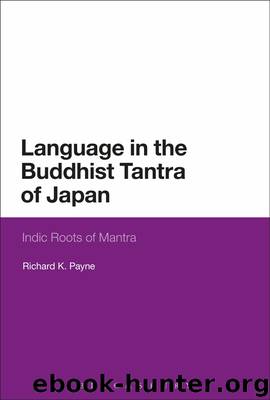Language in the Buddhist Tantra of Japan by Richard K. Payne

Author:Richard K. Payne
Language: eng
Format: epub
Publisher: Bloomsbury UK
Buddhavacana? Speech and Authority
Attention to the dhāraṇī in the Lotus Sūtra introduces an additional issue into the already complex question of the authority of the speech of a buddha (Skt. buddhavacana, discussed earlier in Chapter 7). Initially it might appear that the dhāraṇī are not buddhavacana, because they are introduced by a variety of figures—three bodhisattvas, two devarājas, and a group of ten daughters of rākṣasas along with others of their retinue. Three of the five dhāraṇī introduced in the twenty-sixth chapter, however, are said to have been voiced by buddhas other than Śākyamuni. The first, offered by medicine king Bodhisattva, is reported to have been pronounced “by Buddhas equal in number to the sands of sixty-two millions of Ganges rivers.” The second, given by the bodhisattva Brave Donor, was taught “by as many Buddhas as there are sands in the Ganges river.” And the third, introduced by the god king Realm Holder, was given “by forty-two millions of Buddhas.”33 In this sense, the sutra also addresses, if indirectly, the question of the authority of what a buddha speaks.34 The authority of these hyperbolically numerous buddhas validates the latter dhāraṇī, even though they are spoken in the sutra by bodhisattvas and god kings. Here we see that the authority of buddhavacana, as nuanced in Chapter 7 earlier, extends to dhāraṇī. It is not simply the cognitive, doctrinal content of these dhāraṇī that is authorized by the speech of buddhas but also their efficacy—though as discussed earlier in Chapter 6, authorizing the efficacy of a dhāraṇī is to be distinguished from the idea that they are effective through the founding action of a “culturally postulated superhuman agent.” Furthermore, it is important to note that in the course of the sutra, not all dhāraṇī are validated in this way.
The god king Vaiśravaṇa commits himself to protecting teachers of the dharma “by means of this supernatural charm.”35 Furthermore, he will personally protect Lotus Sūtra adherents. The dhāraṇī pronounced by the daughters of rākśasas is seemingly expected to work of its own accord, causing the head of any demon, human, or fever(-demon?) who has the audacity to attack or torment a teacher of the dharma to split into seven parts.36 Likewise the rākśasa daughters will come personally to protect a Lotus Sūtra pracitioner.37 Similarly, in chapter 28, the bodhisattva Samantabhadra pronounces a dhāraṇī that will protect a teacher of the dharma from attacks by nonhumans or confusion by women (presumably, carnal desire) and commits himself to personally protecting dharma teachers. In these instances, the dhāraṇī do not seem to require any validating reference to having been spoken by buddhas. Instead, it would appear that the authors and compilers of the Lotus Sūtra simply assume that these dhāraṇīs are effective in themselves, that is, spontaneously as with daimoku and nenbutsu as discussed in Chapter 6.
Whether these two ways of presenting the dhāraṇī actually represent significantly different understandings is not evident from the text itself. Some light may be shed, however, by noting the similarity to the way that the efficacy of vows (Skt.
Download
This site does not store any files on its server. We only index and link to content provided by other sites. Please contact the content providers to delete copyright contents if any and email us, we'll remove relevant links or contents immediately.
| Anthropology | Archaeology |
| Philosophy | Politics & Government |
| Social Sciences | Sociology |
| Women's Studies |
The remains of the day by Kazuo Ishiguro(8426)
Tools of Titans by Timothy Ferriss(7846)
Giovanni's Room by James Baldwin(6836)
The Black Swan by Nassim Nicholas Taleb(6792)
Inner Engineering: A Yogi's Guide to Joy by Sadhguru(6463)
The Way of Zen by Alan W. Watts(6304)
Asking the Right Questions: A Guide to Critical Thinking by M. Neil Browne & Stuart M. Keeley(5378)
The Power of Now: A Guide to Spiritual Enlightenment by Eckhart Tolle(5375)
The Six Wives Of Henry VIII (WOMEN IN HISTORY) by Fraser Antonia(5250)
Astrophysics for People in a Hurry by Neil DeGrasse Tyson(5010)
12 Rules for Life by Jordan B. Peterson(4168)
Housekeeping by Marilynne Robinson(4078)
The Ethical Slut by Janet W. Hardy(4047)
Skin in the Game by Nassim Nicholas Taleb(3990)
Double Down (Diary of a Wimpy Kid Book 11) by Jeff Kinney(3949)
Ikigai by Héctor García & Francesc Miralles(3913)
The Art of Happiness by The Dalai Lama(3864)
Skin in the Game: Hidden Asymmetries in Daily Life by Nassim Nicholas Taleb(3743)
Walking by Henry David Thoreau(3702)
